A Novel Areal Maintenance Strategy for Large-Scale Distributed Photovoltaic Maintenance
Abstract
1. Introduction
2. Maintenance Period Decision Model
2.1. Model Overview
2.2. PV Component Reliability Model and Dust Accumulation Model
2.3. Model Implementation
2.4. Maintenance Economic Benefits
2.4.1. Power Generation Loss Cost
2.4.2. Maintenance Cost
2.4.3. Total Economic Benefits
3. Areal Maintenance Strategy
3.1. Strategy Overview
3.2. Model Construction
3.2.1. Objective Function
3.2.2. Constraints
3.3. Model Solution
4. Model Parameters
4.1. Structure of DPV Stations
4.2. Failure Rate and Dust Accumulation Rate
4.3. Economic Parameters
5. Results and Discussion
5.1. Results of Maintenance Period Decision Model
5.2. Results of Areal Maintenance Strategy
6. Conclusions
Author Contributions
Funding
Data Availability Statement
Conflicts of Interest
Abbreviations
| daily base salary for each maintainer, CNY | |
| cleaning cost of one station, CNY | |
| fuel cost per kilometer, CNY | |
| a cutting point | |
| C | sum of the average daily maintenance economic benefits of all DPV stations, CNY |
| base salary for maintainers, CNY | |
| cleaning cost, CNY | |
| loss cost caused by module dust at time t, CNY | |
| loss cost of the i-th station, CNY | |
| loss cost caused by component failure at time t, CNY | |
| loss cost of the i-th station, CNY | |
| average daily maintenance economic benefits, CNY | |
| total economic benefits in a maintenance period, CNY | |
| workload salary for maintainers, CNY | |
| vehicle fuel cost, CNY | |
| d | linear day |
| F | objective function of areal maintenance strategy |
| M | number of individuals |
| number of modules connected to the j-th component | |
| total driving distance of maintenance team | |
| driving distance in each area | |
| maximum number of driving times | |
| total number of offline DPV modules |
| number of maintainers in maintenance team | |
| maximum number of maintainers | |
| number of stations | |
| number of stations in each area | |
| maximum number of stations in area | |
| solution for all stations | |
| total number of components that fail in the maintenance period T of all stations | |
| total number of offline DPV modules | |
| total number of areas | |
| total number of DPV stations | |
| number of fixed stations | |
| number of unresolved stations | |
| total number of modules in one station | |
| total number of online modules at time t | |
| grid-connected electricity price | |
| mutation rate | |
| output power of a single module at time t | |
| r | all the areas |
| random number that follows a uniform distribution | |
| economic benefits | |
| optimal maintenance period | |
| t | time |
| time spent cleaning the dust of one station, h | |
| time spent fixing each failed component, h | |
| maintenance periods, day | |
| v | driving speed, km/h |
| maximum working time of a maintainer for a day, h | |
| individuals | |
| selected individuals for crossover | |
| individual element | |
| each station | |
| failure rate | |
| power generation loss rate |
References
- Baek, Y.J.; Jung, T.Y.; Kang, S.J. Low carbon scenarios and policies for the power sector in Botswana. Clim. Policy 2019, 19, 219–230. [Google Scholar] [CrossRef]
- Ji, Q.; Zhang, D. How much does financial development contribute to renewable energy growth and upgrading of energy structure in China? Energy Policy 2019, 128, 114–124. [Google Scholar] [CrossRef]
- National Energy Administration. Construction and Operation of Photovoltaic Power Generation in 2023. Available online: https://www.nea.gov.cn/2024-02/28/c_1310765696.htm (accessed on 28 February 2024).
- Zhang, A.H.; Sirin, S.M.; Fan, C.; Bu, M. An analysis of the factors driving utility-scale solar PV investments in China: How effective was the feed-in tariff policy? Energy Policy 2022, 2022, 113044. [Google Scholar] [CrossRef]
- Li, Y.; Zhang, Q.; Wang, G.; McLellan, B.; Liu, X.F.; Wang, L. A review of photovoltaic poverty alleviation projects in China: Current status, challenge and policy recommendations. Renew. Sustain. Energy Rev. 2018, 94, 214–223. [Google Scholar] [CrossRef]
- Rahman, M.M.; Khan, I.; Alameh, K. Potential measurement techniques for photovoltaic module failure diagnosis: A review. Renew. Sustain. Energy Rev. 2021, 151, 111532. [Google Scholar] [CrossRef]
- Osmani, K.; Haddad, A.; Lemenand, T.; Castanier, B.; Ramadan, M. A review on maintenance strategies for PV systems. Sci. Total Environ. 2020, 746, 141753. [Google Scholar] [CrossRef]
- Iftikhar, H.; Sarquis, E.; Branco, P.C. Why can simple operation and maintenance (O&M) practices in large-scale grid-connected PV power plants play a key role in improving its energy output? J. Abbr. 2021, 14, 3798. [Google Scholar]
- Yuan, J.; Sun, S.; Zhang, W.; Xiong, M. The economy of distributed PV in China. Energy 2014, 78, 939–949. [Google Scholar] [CrossRef]
- Perdue, M.; Gottschalg, R. Energy yields of small grid connected photovoltaic system: Effects of component reliability and maintenance. IET Renew. Power Gener. 2015, 9, 432–437. [Google Scholar] [CrossRef]
- Siemer, J. Operation & Maintenance. 2016, pp. 36–39. Available online: https://kh.aquaenergyexpo.com/wp-content/uploads/2023/01/Operation-Maintenance-Best-Practice-Guidelines.pdf (accessed on 19 August 2024).
- Enbar, N.; Weng, D.; Klise, G.T. Budgeting for Solar PV Plant Operations & Maintenance: Practices and Pricing; Sandia National Lab. (SNL-NM): Albuquerque, NM, USA, 2016.
- Zhang, P.; Li, W.; Li, S.; Wang, Y.; Xiao, W. Reliability assessment of photovoltaic power systems: Review of current status and future perspectives. Appl. Energy 2013, 104, 822–833. [Google Scholar] [CrossRef]
- Collins, E.; Dvorack, M.; Mahn, J.; Mundt, M.; Quintana, M. Reliability and availability analysis of a fielded photovoltaic system. In Proceedings of the 2009 34th IEEE Photovoltaic Specialists Conference (PVSC), Philadelphia, PA, USA, 7–12 June 2009; pp. 002316–002321. [Google Scholar]
- Ahadi, A.; Ghadimi, N.; Mirabbasi, D. Reliability assessment for components of large scale photovoltaic systems. J. Power Sources 2014, 264, 211–219. [Google Scholar] [CrossRef]
- Sanjari, M.J.; Gooi, H. Probabilistic forecast of PV power generation based on higher order Markov chain. IEEE Trans. Power Syst. 2016, 32, 2942–2952. [Google Scholar] [CrossRef]
- Lu, H.; Zhao, W. Effects of particle sizes and tilt angles on dust deposition characteristics of a ground-mounted solar photovoltaic system. Appl. Energy 2018, 220, 514–526. [Google Scholar] [CrossRef]
- Darwish, Z.A.; Kazem, H.A.; Sopian, K.; Al-Goul, M.; Alawadhi, H. Effect of dust pollutant type on photovoltaic performance. Renew. Sustain. Energy Rev. 2015, 41, 735–744. [Google Scholar] [CrossRef]
- Zaihidee, F.M.; Mekhilef, S.; Seyedmahmoudian, M.; Horan, B. Dust as an unalterable deteriorative factor affecting PV panel’s efficiency: Why and how. Renew. Sustain. Energy Rev. 2016, 65, 1267–1278. [Google Scholar] [CrossRef]
- Muñoz-Cerón, E.; Lomas, J.; Aguilera, J.; de la Casa, J. Influence of Operation and Maintenance expenditures in the feasibility of photovoltaic projects: The case of a tracking pv plant in Spain. Energy Policy 2018, 121, 506–518. [Google Scholar] [CrossRef]
- Zheng, Y.; Xia, Z.; Luo, Y.; Chen, Y.; Zhou, L.; Peng, J. Research on operation and maintenance mode of photovoltaic poverty alleviation power station based on fuzzy analytic hierarchy process. Electr. Power 2021, 54, 191–198. [Google Scholar]
- Carrasco, L.; Martín-Campo, F.J.; Narvarte, L.; Ortuño, M.T.; Vitoriano, B. Design of maintenance structures for rural electrification with solar home systems. The case of the Moroccan program. Energy 2016, 117, 47–57. [Google Scholar] [CrossRef]
- Villarini, M.; Cesarotti, V.; Alfonsi, L.; Introna, V. Optimization of photovoltaic maintenance plan by means of a FMEA approach based on real data. Energy Convers. Manag. 2017, 152, 1–12. [Google Scholar] [CrossRef]
- Hammad, B.; Al-Abed, M.; Al-Ghandoor, A.; Al-Sardeah, A.; Al-Bashir, A. Modeling and analysis of dust and temperature effects on photovoltaic systems’ performance and optimal cleaning frequency: Jordan case study. Renew. Sustain. Energy Rev. 2018, 82, 2218–2234. [Google Scholar] [CrossRef]
- ISO 9000:2015; Quality Management Systems—Fundamentals and Vocabulary. International Standards Organization: Geneva, Switzerland, 2015.
- Jardine, A.K.; Tsang, A.H. Maintenance, Replacement, and Reliability: Theory and Applications; CRC Press: Boca Raton, FL, USA, 2005. [Google Scholar]
- Spertino, F.; Chiodo, E.; Ciocia, A.; Malgaroli, G.; Ratclif, A. Maintenance activity, reliability, availability, and related energy losses in ten operating photovoltaic systems up to 1.8 MW. IEEE Trans. Ind. Appl. 2020, 57, 83–93. [Google Scholar] [CrossRef]
- Jones, R.K.; Baras, A.; Al Saeeri, A.; Al Qahtani, A.; Al Amoudi, A.O.; Al Shaya, Y.; Alodan, M.; Al-Hsaien, S.A. Optimized cleaning cost and schedule based on observed soiling conditions for photovoltaic plants in central Saudi Arabia. IEEE J. Photovoltaics 2016, 6, 730–738. [Google Scholar] [CrossRef]
- Zhao, Y.; Ball, R.; Mosesian, J.; de Palma, J.F.; Lehman, B. Graph-based semi-supervised learning for fault detection and classification in solar photovoltaic arrays. IEEE Trans. Power Electron. 2014, 30, 2848–2858. [Google Scholar] [CrossRef]
- Gallardo-Saavedra, S.; Hernández-Callejo, L.; Duque-Pérez, O. Quantitative failure rates and modes analysis in photovoltaic plants. Energy 2019, 183, 825–836. [Google Scholar] [CrossRef]
- Colli, A. Failure mode and effect analysis for photovoltaic systems. Renew. Sustain. Energy Rev. 2015, 50, 804–809. [Google Scholar] [CrossRef]

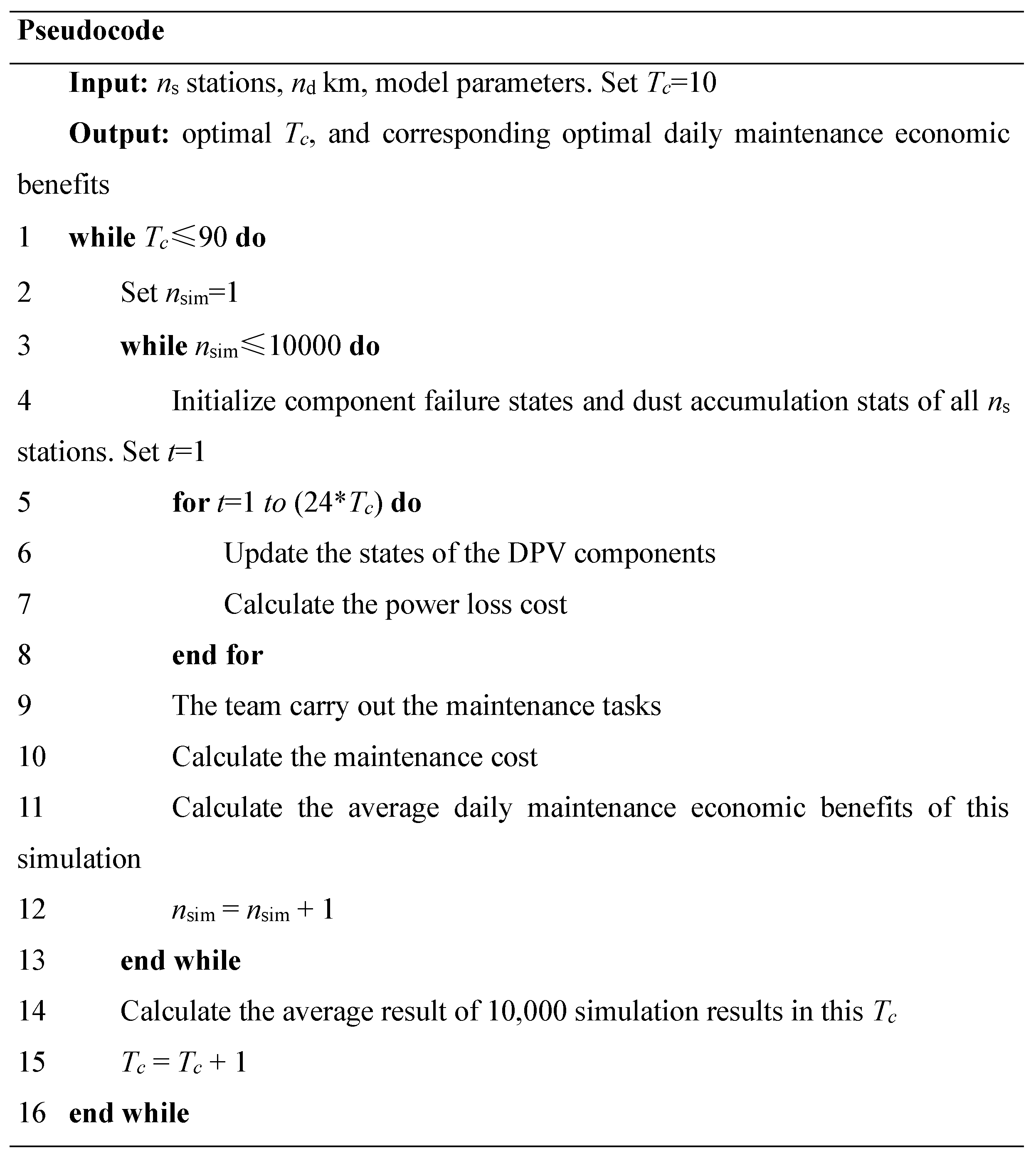

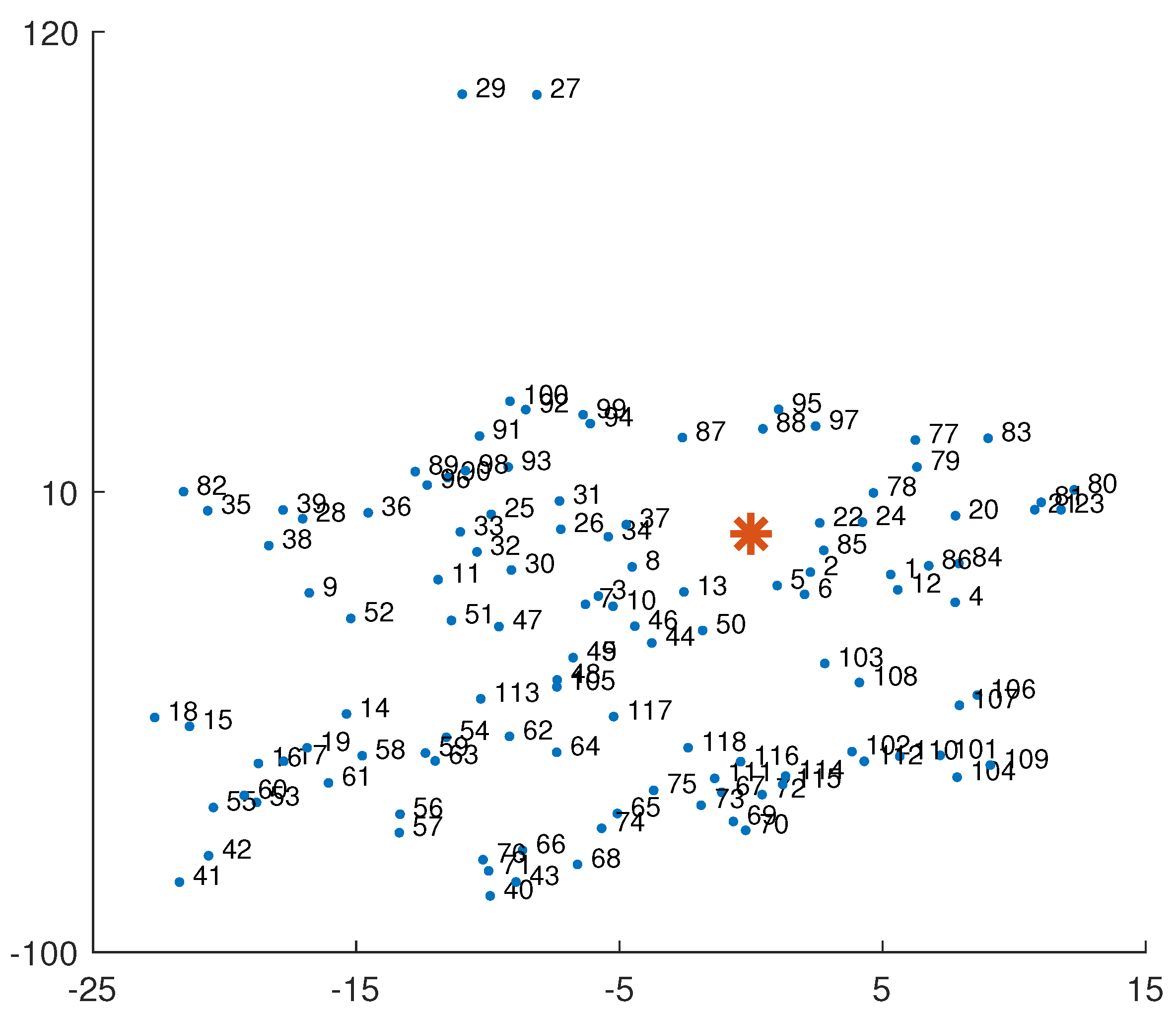
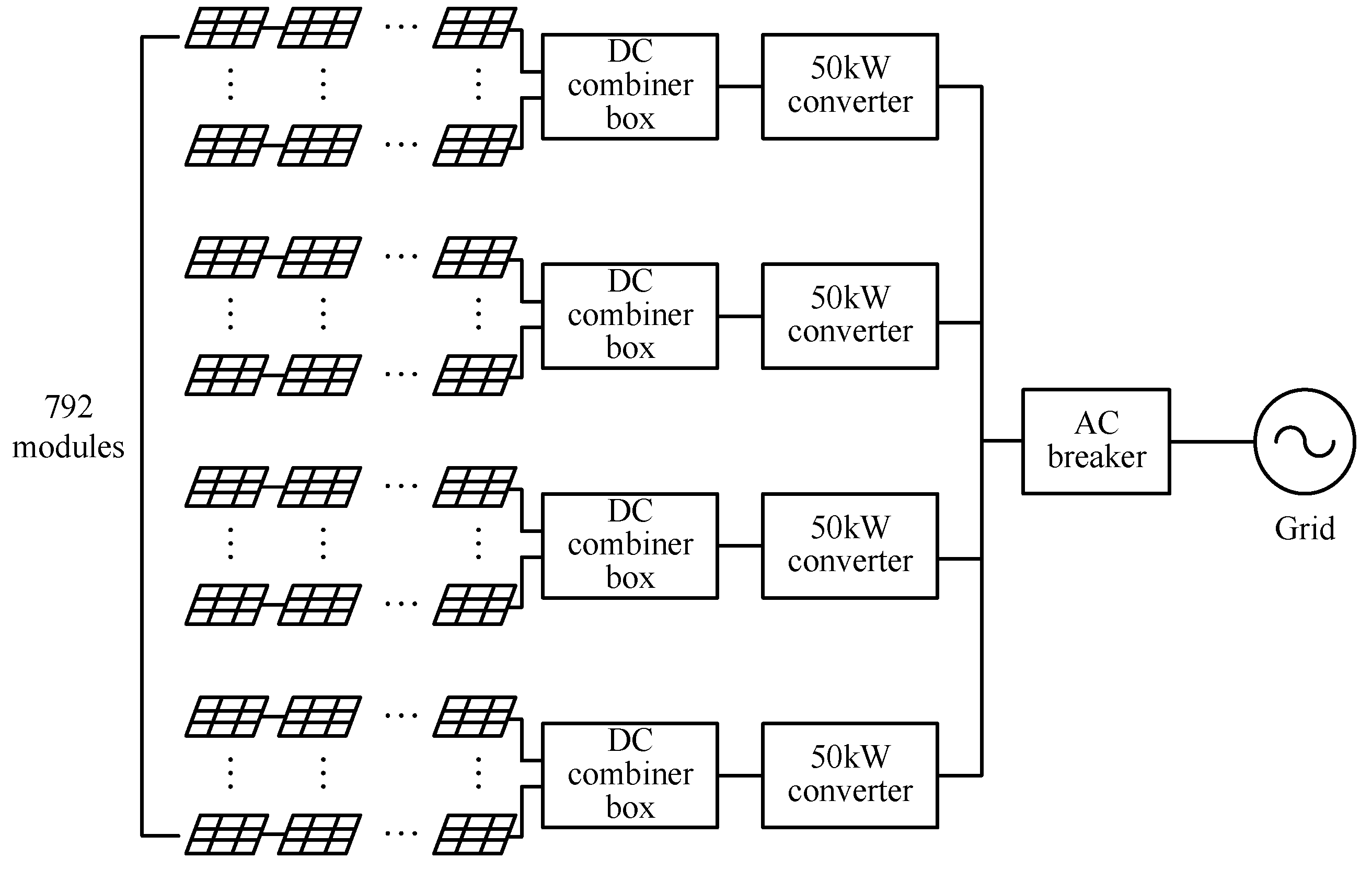


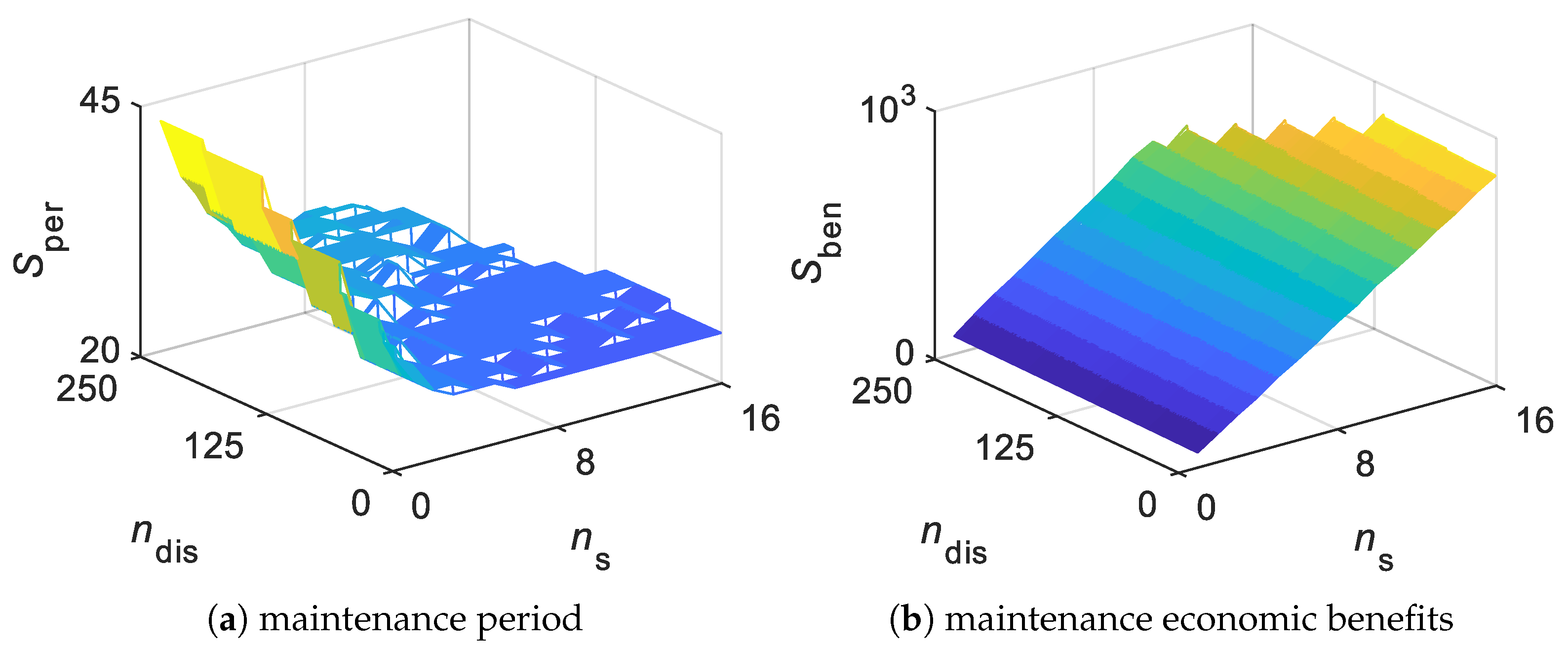
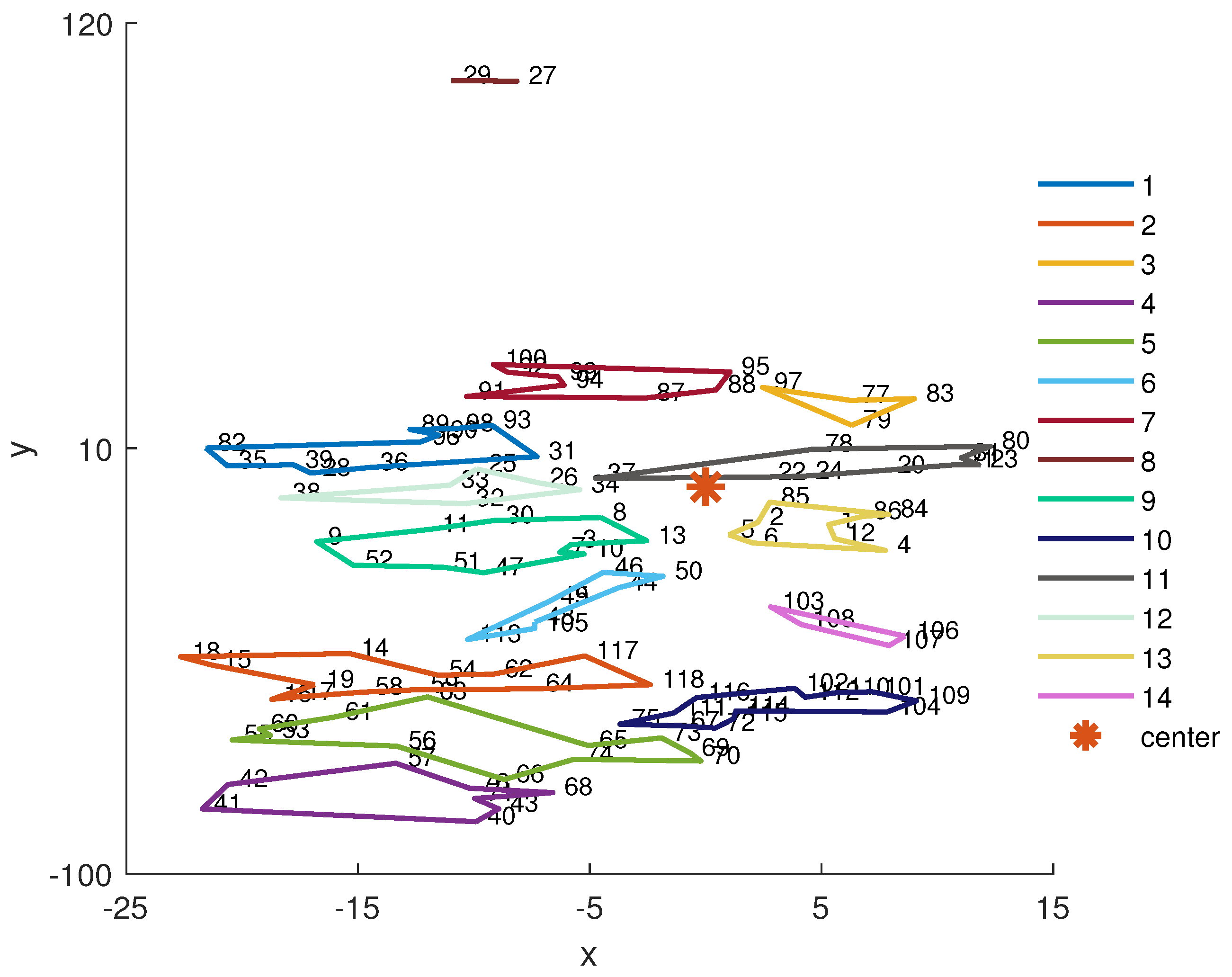
| Component | Failures/h |
|---|---|
| PV module | 0.33 × |
| DC combiner box | 45.13 × |
| String inverter | 12.90 × |
| AC circuit breaker | 5.71 × |
| Component | Number of Modules |
|---|---|
| PV module | 11 |
| DC combiner box | 198 |
| String inverter | 198 |
| AC circuit breaker | 792 |
| Maintenance Area | Stations |
|---|---|
| 1 | 89 90 93 96 98 |
| 2 | 16 17 58 59 |
| 3 | 77 83 79 |
| 4 | 40 41 42 43 68 71 76 |
| 5 | 65 66 69 70 73 74 |
| 6 | 44 105 113 |
| 7 | 87 91 92 94 99 100 |
| 8 | 27 29 |
| 9 | 51 52 |
| 10 | 67 72 101 102 104 109 110 112 114 115 |
| 11 | 20 21 23 80 81 |
| Maintenance Area | Number of Stations | Driving Distance | Number of Maintainers | ||
|---|---|---|---|---|---|
| 1 | 11 (89 90 93 96 98 28 31, 35 36 39 82) | 64 | 25 | 592.2 | 5 |
| 2 | 13 (16 17 58 59 14 15 18 19 54 62 64 117 118) | 141 | 26 | 716.9 | 7 |
| 3 | 4 (77 83 79 97) | 58 | 26 | 219.4 | 2 |
| 4 | 8 (40 41 42 43 68 71 76 57) | 192 | 29 | 455.3 | 5 |
| 5 | 12 (65 66 69 70 73 74 53 55 56 60 61 63) | 175 | 27 | 671.6 | 7 |
| 6 | 8 (44 105 113 45 46 48 49 50) | 83 | 26 | 436.0 | 4 |
| 7 | 8 (87 91 92 94 99 100 88 95) | 79 | 26 | 435.6 | 4 |
| 8 | 2 (27 29) | 214 | 35 | 131.6 | 2 |
| 9 | 11 (51 52 3 7 8 9 10 11 13 30 47) | 63 | 25 | 592.1 | 5 |
| 10 | 13 (67 72 101 102 104 109 110 112 114 115 75 111 116) | 142 | 26 | 717.1 | 7 |
| 11 | 9 (20 21 23 80 81 22 24 37 78) | 44 | 26 | 483.4 | 4 |
| 12 | 6 (25 26 32 33 34 38) | 44 | 26 | 325.6 | 3 |
| 13 | 9 (1 2 4 5 6 12 84 85 86) | 43 | 26 | 483.3 | 4 |
| 14 | 4 (103 106 107 108) | 85 | 27 | 224.2 | 2 |
Disclaimer/Publisher’s Note: The statements, opinions and data contained in all publications are solely those of the individual author(s) and contributor(s) and not of MDPI and/or the editor(s). MDPI and/or the editor(s) disclaim responsibility for any injury to people or property resulting from any ideas, methods, instructions or products referred to in the content. |
© 2024 by the authors. Licensee MDPI, Basel, Switzerland. This article is an open access article distributed under the terms and conditions of the Creative Commons Attribution (CC BY) license (https://creativecommons.org/licenses/by/4.0/).
Share and Cite
Yin, D.; Zhu, Y.; Qiang, H.; Zheng, J.; Zhang, Z. A Novel Areal Maintenance Strategy for Large-Scale Distributed Photovoltaic Maintenance. Electronics 2024, 13, 3593. https://doi.org/10.3390/electronics13183593
Yin D, Zhu Y, Qiang H, Zheng J, Zhang Z. A Novel Areal Maintenance Strategy for Large-Scale Distributed Photovoltaic Maintenance. Electronics. 2024; 13(18):3593. https://doi.org/10.3390/electronics13183593
Chicago/Turabian StyleYin, Deyang, Yuanyuan Zhu, Hao Qiang, Jianfeng Zheng, and Zhenzhong Zhang. 2024. "A Novel Areal Maintenance Strategy for Large-Scale Distributed Photovoltaic Maintenance" Electronics 13, no. 18: 3593. https://doi.org/10.3390/electronics13183593
APA StyleYin, D., Zhu, Y., Qiang, H., Zheng, J., & Zhang, Z. (2024). A Novel Areal Maintenance Strategy for Large-Scale Distributed Photovoltaic Maintenance. Electronics, 13(18), 3593. https://doi.org/10.3390/electronics13183593








